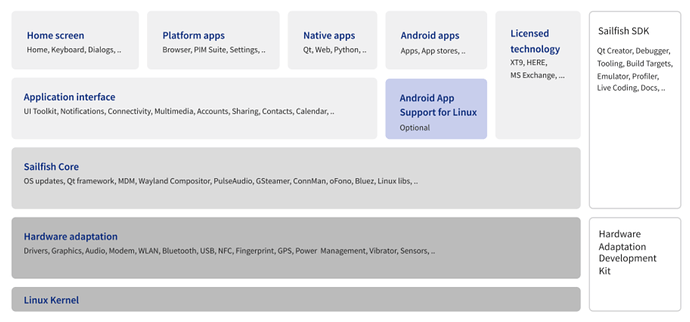Communication
Probably or possibly because many people arrive to the same conclusion based on the same obsevervations. This does not mean that because many people see the Sun moving, then it is the Sun turning around the Earth. Observations and facts are two distincts categories.
Moreover, if you need to repeat things then it is time to write a post about those things and pass that link to everyone faces the same question/doubt. Ouch, it will be crossposting sharing a link among many threads. ![]()
Documentation
For this reason, I took a look to the SailFish OS Whitepaper and I noticed that the origin of the project are rooted in 2004 which is about 20 years ago, while the first release of Android is reported back to September 23, 2008 which are 14 years ago.
That was about Nokia, then Jolla started over on 2013 with SailFish OS.
Xperia 10 II get into Sony OpenDevice program in June 2020. Soon later the Android App Support was introduced into SailFish OS in Q4, 2020 (c.a. 6 months later) while the Android support for automotive in 2021. We can assume that “playing” with X10 II was a testbench to move the Jolla business in a more profitable market and give up the competition with Android (totally replace it, I mean).
Present
Therefore, the most interesting things happen between Q2,2020 and Q2,2021. However, the Xperia 10 II hardware support by SailFish OS can be considered nearly completed with the microG preview release on 29th May 2023.
Hardware support
Yes, hardware support. In fact, searching in the forum you will easily found references about the microG preview release solves a problem with the GPS. Whatever you might argue: if native and Android apps, both have problem with the GPS because the release version of microG, then microG should be considered part of the hardware support under the point of functionality,
Couriosly, I received my Xperia 10 II on 26th May 2023 just 3 days before the preview release of microG came out.
System Architecture
What you have said, many many times, is depicted here at the page 18:
The Android App Support is optional and separate by everything else. In particular at page 8, FireJail is cited as network security appliance (firewall manager): “apps have been sandboxed by Firejail and core
system services by systemd sandboxing”. Unfortunately, I did not find the SailJail which is expected to be delivered sometime in the future to achieve the fine control of network activities by the users.
Technical feedback
Finally, it is your turn. Look at the image and tell me where the microG is placed in that architecture infographic. IMHO, I guess it should stay - in terms of fuctionalities - in the hardware adaptation layer and also in the layer above, like in this picture:
Confrontation
Now, it is easy to confute me. I am not interested in, where it is installed the microG software. Nor of what is supposed it should do or not do. I am interested in, placing its funtional¹ role in this diagram. ![]()
NOTES
¹ functional, what in practice is able to influence in a senstive way.

